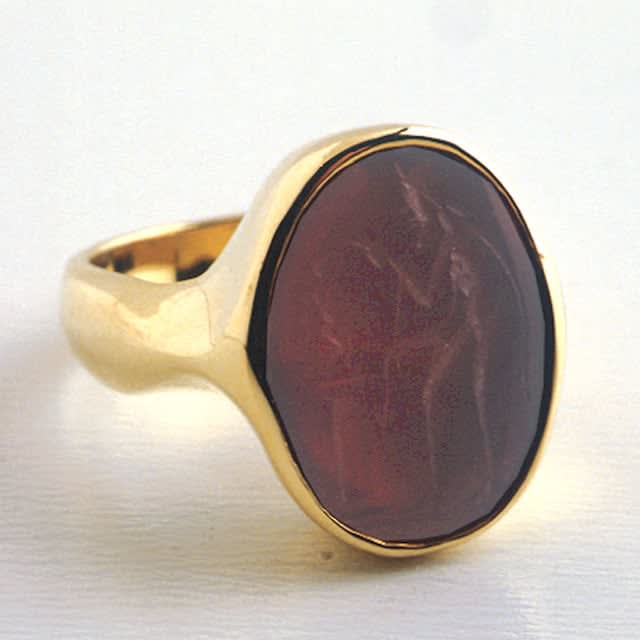Classical Revival Intaglio of Hercules and Pan, 1700 CE - 1800 CE
Gem-Gold
FJ.6440
This intaglio is set in an 18 karat gold rin The art of glyptics, or carving on colored precious stones, is probably one of the oldest known to humanity. Intaglios,...
This intaglio is set in an 18 karat gold rin
The art of glyptics, or carving on colored precious stones, is probably one of the oldest known to humanity. Intaglios, gems with an incised design, were made as early as the fourth and third millennia BC in Mesopotamia and Aegean Islands. They display a virtuosity of execution that suggests an old and stable tradition rooted in the earliest centuries. The tools required for carving gems were simple: a wheel with a belt-drive and a set of drills. Abrasives were necessary since the minerals used were too hard for a metal edge. A special difficulty of engraving intaglios, aside from their miniature size, was that the master had to work with a mirror-image in mind.
The particular charm of this intaglio is the depiction of two very unlikely companions--Hercules and Pan. The former was the ancient world's most famous 'strong-man', a match for any man or beast, and an important player on the stage of Greek mythology and literature. Even from the cradle his superhuman strength was evident, having killed a two large snakes which tried to strangle him. Pan, however, was more interested in pastoral pursuits and chasing beautiful nymphs than in combat. God of shepherds and flocks, Pan lived in the woodlands enjoying cool streams and music. On this intaglio he is standing on a pillar being 'talked-to' by the much larger figure of Hercules. There is a feeling of humor and mirth, as if Hercules is pointing out a moral lesson the amorous Pan is unlikely to follow. The engraver obviously took as much delight in depicting these two mythical figures, as we do in seeing the finished work.
The art of glyptics, or carving on colored precious stones, is probably one of the oldest known to humanity. Intaglios, gems with an incised design, were made as early as the fourth and third millennia BC in Mesopotamia and Aegean Islands. They display a virtuosity of execution that suggests an old and stable tradition rooted in the earliest centuries. The tools required for carving gems were simple: a wheel with a belt-drive and a set of drills. Abrasives were necessary since the minerals used were too hard for a metal edge. A special difficulty of engraving intaglios, aside from their miniature size, was that the master had to work with a mirror-image in mind.
The particular charm of this intaglio is the depiction of two very unlikely companions--Hercules and Pan. The former was the ancient world's most famous 'strong-man', a match for any man or beast, and an important player on the stage of Greek mythology and literature. Even from the cradle his superhuman strength was evident, having killed a two large snakes which tried to strangle him. Pan, however, was more interested in pastoral pursuits and chasing beautiful nymphs than in combat. God of shepherds and flocks, Pan lived in the woodlands enjoying cool streams and music. On this intaglio he is standing on a pillar being 'talked-to' by the much larger figure of Hercules. There is a feeling of humor and mirth, as if Hercules is pointing out a moral lesson the amorous Pan is unlikely to follow. The engraver obviously took as much delight in depicting these two mythical figures, as we do in seeing the finished work.
